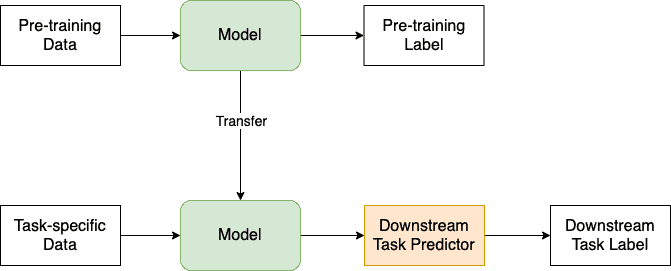1. Introduction
In this tutorial, we’ll talk about downstream tasks in machine learning.
A downstream task depends on the output of a previous task or process. It involves applying the pre-trained model‘s knowledge to a new problem. The output of the previous task serves as input to the downstream task, and the model can only perform the downstream task once completing the previous one.
2. Why Is Downstreaming Useful?
The idea of pre-training models on upstream tasks and fine-tuning on downstream tasks is also known as transfer learning. The goal of transfer learning is to use the information gained from pre-training a model on a large dataset to enhance the performance of the same or a related model on a different, more specific job or a smaller dataset:

Downstream tasks allow us to use pre-trained models for various applications. By fine-tuning the models on specific downstream tasks, we can improve their performance and make them more useful for other real-world applications.
A benefit of this approach is that we don’t need to construct new models from scratch. Instead, we can adjust the existing quality models. That produces leading results on many tasks.
3. How Does It Work?
In the fine-tuning process, we first use the parameters of the pre-trained model as the initial values. Then, we adjust the parameter based on the gradient of the error to optimize the model’s performance on the new task. Once the model has been fine-tuned, we can use it to make predictions or perform other tasks related to the downstream task:

In neural networks, we can apply backpropagation to update the weights/parameters in the networks.
We adapt the general knowledge learned during pre-training to solve specific tasks by fine-tuning the pre-trained model or using its outputs as input.
3.1. Downstream Tasks in Natural Language Processing (NLP)
For example, in the case of large language models like GPT and BERT, we first train our model on large amounts of general text data to learn the language. Then, we fine-tune the model to perform specific downstream tasks:
- Sentiment analysis, where we determine the sentiment (positive, negative, or neutral) of a text, such as a product review or social media post
- Text classification, in which we assign a label or category to a piece of text, such as identifying the topic of a news article or classifying an email as spam or not spam
- Named entity recognition for identifying and categorizing named entities (such as people, places, and organizations) in a text
- Question answering, which is about generating answers to questions based on a given text or knowledge base
- Text summarization, where we find a summary of a longer piece of text, such as a news article or research paper
3.2. Downstream Tasks in Computer Vision
In image classification, a pre-trained convolutional neural network (CNN) can be used as a feature extractor to extract features from input images. Then, we use these features in downstream tasks to:
- identify and locate objects of interest in an image or video, such as cars or people – object detection
- divide an image into multiple regions or segments, such as the foreground and background – image segmentation
- identify individuals in images or videos based on their facial features – facial recognition
- generate natural-language descriptions of the content of an image or a video-image captioning
4. Shortcomings
Transfer learning can be computationally expensive, particularly if the target dataset or the pre-trained model is large and complex.
Additionally, transfer learning works best when the source and target activities are similar or overlap in some way. This is intuitive since we don’t expect a model trained to recognize objects in an image to be easily adapted to handle textual data. So, transfer learning might not work well if the pre-trained and downstream tasks are dissimilar.
5. Conclusion
In this article, we explain downstream tasks in machine learning.
A downstream task is a task that depends on the output of a previous task or process. This idea is based on transfer learning, which allows us to use pre-trained models to improve performance on specific tasks. By fine-tuning the models on the downstream tasks, we can make the models more effective for real-world applications.